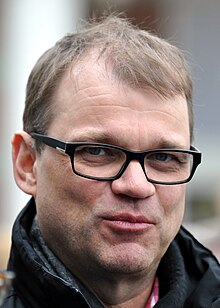Prime Minister of Finland
| Prime Minister of the Republic of Finland Suomen pääministeri Statsminister Republiken Finland |
|
|---|---|

|
|
| Style | Excellency |
| Member of |
Cabinet European Council |
| Residence | Kesäranta |
| Appointer | The President of the Republic |
| Term length | No fixed term Duration of parliamentary convocation, coalition or upon resignation and removal |
| Formation | 27 November 1917 |
| First holder | Pehr Evind Svinhufvud |
| Website | vnk |
The Prime Minister (Finnish: pääministeri, literally translated as Head Minister, Swedish: statsminister, literally translated as Minister of State) is the Head of Government of Finland. The Prime Minister is appointed by the President, who is the Head of State. The current Prime Minister is Juha Sipilä of the Centre Party.
Under the provisions of the new Constitution of Finland (enacted in 2000), the President nominates a Prime Minister after the parties in the Eduskunta/Riksdag (Parliament) have negotiated the distribution of seats in the new Council of State and the government's programme. Parliament must ratify the nominated Prime Minister with an absolute majority in a vote without other candidates. If the nominee doesn't receive sufficient support, then a new round of negotiations and a second nomination by the President follows. If the second nominee also fails to gain an absolute majority, then a third vote occurs, in which any member of Parliament can nominate a candidate; in this round a plurality is sufficient for election. The President's formal appointment follows Parliament's election.
The above procedure was first used to elect Anneli Jäätteenmäki to the premiership in 2003. Previously it was assumed that the President would nominate the candidate who in a third round of voting would have gained a relative majority, usually the leader of the largest party. Before the new Constitution came into force, full formal powers to appoint the Prime Minister and the rest of the Council of State had been the privilege of the President, who was free to diverge from parliamentary principles, although ministers appointed had to have the confidence of the Parliament.
...
Wikipedia

